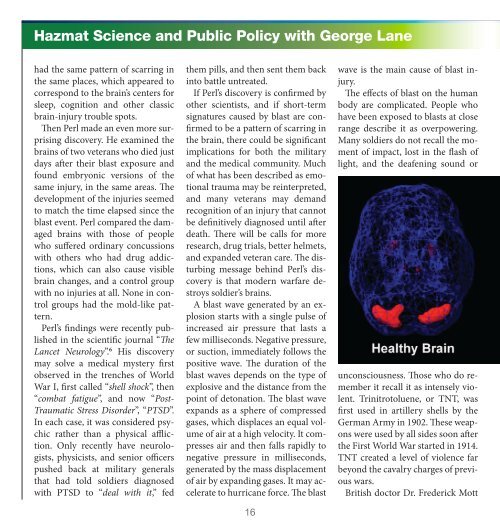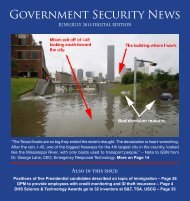GSN Magazine June 2016 Digital Edition
Create successful ePaper yourself
Turn your PDF publications into a flip-book with our unique Google optimized e-Paper software.
Hazmat Science and Public Policy with George Lane<br />
had the same pattern of scarring in<br />
the same places, which appeared to<br />
correspond to the brain’s centers for<br />
sleep, cognition and other classic<br />
brain-injury trouble spots.<br />
Then Perl made an even more surprising<br />
discovery. He examined the<br />
brains of two veterans who died just<br />
days after their blast exposure and<br />
found embryonic versions of the<br />
same injury, in the same areas. The<br />
development of the injuries seemed<br />
to match the time elapsed since the<br />
blast event. Perl compared the damaged<br />
brains with those of people<br />
who suffered ordinary concussions<br />
with others who had drug addictions,<br />
which can also cause visible<br />
brain changes, and a control group<br />
with no injuries at all. None in control<br />
groups had the mold-like pattern.<br />
Perl’s findings were recently published<br />
in the scientific journal “The<br />
Lancet Neurology”. 6 His discovery<br />
may solve a medical mystery first<br />
observed in the trenches of World<br />
War I, first called “shell shock”, then<br />
“combat fatigue”, and now “Post-<br />
Traumatic Stress Disorder”, “PTSD”.<br />
In each case, it was considered psychic<br />
rather than a physical affliction.<br />
Only recently have neurologists,<br />
physicists, and senior officers<br />
pushed back at military generals<br />
that had told soldiers diagnosed<br />
with PTSD to “deal with it,” fed<br />
them pills, and then sent them back<br />
into battle untreated.<br />
If Perl’s discovery is confirmed by<br />
other scientists, and if short-term<br />
signatures caused by blast are confirmed<br />
to be a pattern of scarring in<br />
the brain, there could be significant<br />
implications for both the military<br />
and the medical community. Much<br />
of what has been described as emotional<br />
trauma may be reinterpreted,<br />
and many veterans may demand<br />
recognition of an injury that cannot<br />
be definitively diagnosed until after<br />
death. There will be calls for more<br />
research, drug trials, better helmets,<br />
and expanded veteran care. The disturbing<br />
message behind Perl’s discovery<br />
is that modern warfare destroys<br />
soldier’s brains.<br />
A blast wave generated by an explosion<br />
starts with a single pulse of<br />
increased air pressure that lasts a<br />
few milliseconds. Negative pressure,<br />
or suction, immediately follows the<br />
positive wave. The duration of the<br />
blast waves depends on the type of<br />
explosive and the distance from the<br />
point of detonation. The blast wave<br />
expands as a sphere of compressed<br />
gases, which displaces an equal volume<br />
of air at a high velocity. It compresses<br />
air and then falls rapidly to<br />
negative pressure in milliseconds,<br />
generated by the mass displacement<br />
of air by expanding gases. It may accelerate<br />
to hurricane force. The blast<br />
16<br />
wave is the main cause of blast injury.<br />
The effects of blast on the human<br />
body are complicated. People who<br />
have been exposed to blasts at close<br />
range describe it as overpowering.<br />
Many soldiers do not recall the moment<br />
of impact, lost in the flash of<br />
light, and the deafening sound or<br />
unconsciousness. Those who do remember<br />
it recall it as intensely violent.<br />
Trinitrotoluene, or TNT, was<br />
first used in artillery shells by the<br />
German Army in 1902. These weapons<br />
were used by all sides soon after<br />
the First World War started in 1914.<br />
TNT created a level of violence far<br />
beyond the cavalry charges of previous<br />
wars.<br />
British doctor Dr. Frederick Mott







